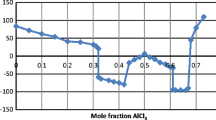Summary
The permeability coefficient determined with isotopically labeled solvent (water) and the permeability coefficient determined from the volume flow under the influence of an osmotic gradient are different, if the solvent is considered to be reversibly associated. This is shown by application of the equations of irreversible thermodynamics to systems with an associating substance. An equation is derived which relates the permeability ratio to the average cluster size of the solvent.
Similar content being viewed by others
References
Cass, A., Finkelstein, A. 1967. Water permeability of thin lipid membranes.J. Gen. Physiol. 50:1765
Dainty, J., Ginzburg, B.Z. 1963. Irreversible thermodynamics and frictional models of membrane processes, with particular reference to the cell membrane.J. Theor. Biol. 5:256
Goldstein, D.A., Solomon, A.K. 1960. Determination of equivalent pore radius for human red cells by osmotic pressure measurements.J. Gen. Physiol. 44:1
Kedem, O., Essig, A. 1965. Isotope flows and flux ratios in biological membranes.J. Gen. Physiol. 48:1047
Kedem, O., Katchalsky, A. 1958. Thermodynamic analysis of the permeability of biological membranes to nonelectrolytes.Biochim. Biophys. Acta 27:229
Kedem, O., Katchalsky, A. 1961. A physical interpretation of the phenomenological coefficients of membrane permeability.J. Gen. Physiol. 45:143
Koefoed-Johnsen, V., Ussing, H.H. 1953. The contributions of diffusion and flow to the passage of D2O through living membranes.Acta Physiol. Scand. 28:60
Mauro, A. 1957. Nature of solvent transfer in osmosis.Science 126:252
Pappenheimer, J.R., Renkin, E.M., Borrero, L.M. 1951. Filtration, diffusion and molecular sieving through peripheral capillary membranes.Am. J. Physiol. 167:13
Schönert, H. 1978. Transport of isotopes in systems with reversibly reacting species. II. Binary and ternary non-electrolyte solutions with association reactions.Ber. Bunsenges. Phys. Chem. 82:731
Solomon, A.K. 1968. Characterization of biological membranes by equivalent pores.J. Gen. Physiol. 51:335
Stein, W.D., 1967. The Movement of Molecules across Cell Membranes. Academic Press, New York
Thau, G., Bloch, R., Kedem, O. 1966. Water transport in porous and non-porous membranes.Desalination 1:129
Author information
Authors and Affiliations
Rights and permissions
About this article
Cite this article
Schönert, H. Anomalous permeation of a reversibly associating substance: Hydraulic conductivity and tracer water diffusion. J. Membrain Biol. 52, 161–164 (1980). https://doi.org/10.1007/BF01869121
Received:
Revised:
Issue Date:
DOI: https://doi.org/10.1007/BF01869121




